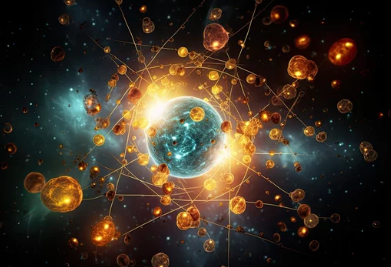Are you curious about the structures that safely house powerful nuclear reactions? In this article, we’ll delve into the world of nuclear physics and explore the construction of facilities used for this purpose. Nuclear physics aims to understand atomic nuclei’s structure, dynamics, and the forces that bind them. Scientists study nuclear binding limits and element origins to unravel the mysteries of the universe. Join us on this journey as we explore intricate structures that harness nuclear reactions’ power while ensuring safety and sustainability.
Nuclear Fission Basics
To understand nuclear fission, you must learn about the basics of this controlled nuclear reaction. Nuclear fission is a process in which the nucleus of an atom splits into smaller nuclei, releasing energy. This reaction is initiated by the capture of neutrons or photons by the nucleus. The fission chain reaction occurs when the extra neutrons generated from the fission reactions collide with nearby nuclei, causing them to undergo fission as well.
In order to facilitate the controlled nuclear fission reaction, nuclear reactors are designed with specific containment materials and structures. The nuclear fuel rods, which contain the fissionable material such as uranium-235, are arranged in a nuclear fuel assembly. This assembly is then placed in the core of the nuclear reactor. The containment materials, such as concrete or steel, surround the reactor to ensure the safe confinement of the fission reactions.
The design of a nuclear reactor plays a crucial role in maintaining the controlled nuclear fission reaction. The reactor design includes various safety mechanisms to prevent accidents and ensure the safe operation of the reactor. These mechanisms include control rods, which absorb neutrons to control the rate of the fission chain reaction, and coolant systems, such as water or liquid sodium, to remove the heat generated by the fission reactions.
Energy Release in Nuclear Fission
When exploring the energy release in nuclear fission, it is important to understand the primary source of this energy. In nuclear fission reactions, the energy is primarily released as kinetic energy carried away by neutrons. These neutrons, generated during the fission process, have high levels of kinetic energy. To harness this energy, nuclear fuel, such as uranium-235, is used in nuclear reactors. When the fuel undergoes fission, it releases a large amount of energy in the form of kinetic energy of the neutrons. This energy must be captured and converted into a usable form for power production.
One way to convert this energy is through the process of neutron moderation. Neutrons, initially produced with high kinetic energy, are slowed down or moderated by colliding with protons in water molecules. This moderation process not only slows down the neutrons but also acts as a coolant for the reactor. The slowed-down neutrons can then be captured by other uranium-235 atoms, initiating a self-sustaining nuclear chain reaction.
The energy released from nuclear fission reactions is then used to produce steam, which drives a turbine connected to a generator to generate electricity. The fission products, which are the smaller nuclei produced during the fission process, are highly radioactive and must be carefully managed. Reactor cooling systems are employed to remove heat from the reactor and prevent overheating.
Nuclear Fission Reactors and Power Generation
Nuclear fission reactors provide a reliable and efficient source of power for electricity generation. These reactors are designed to harness the energy released from nuclear fission reactions. The reactor design involves careful consideration of factors such as nuclear fuel, neutron moderation, control rods, and power production.
Nuclear fuel, typically uranium-235 or plutonium-239, is used as the primary fuel in these reactors. The fuel undergoes fission when bombarded by neutrons, releasing a large amount of energy. Neutron moderation is a crucial aspect of reactor design, as it involves slowing down the fast neutrons produced during fission. This is achieved by using a moderator such as water or graphite, which helps to increase the efficiency of the fission process.
Control rods are another important component of nuclear fission reactors. These rods are made of materials such as boron or cadmium, which absorb neutrons. By adjusting the position of the control rods, the rate of the fission reaction can be controlled, ensuring safe and stable operation of the reactor.
The power produced by nuclear fission reactors is generated through the conversion of heat into electricity. The heat generated by the fission reactions is used to create steam, which drives a turbine connected to a generator. This process is similar to conventional power plants, but instead of using fossil fuels, nuclear fission is used as the heat source.
Radiation and Safety in Nuclear Fission
Your safety is of utmost importance when it comes to radiation in nuclear fission. Nuclear fission reactions produce gamma radiation, which can be harmful to human health. Therefore, radiation protection measures and nuclear safety protocols are in place to ensure the safe operation of nuclear power plants.
One important aspect of safety in nuclear fission is reactor containment design. The containment structure is designed to prevent the release of radioactive materials into the environment in the event of a nuclear accident. It is made of thick layers of concrete and steel, which act as barriers to contain any potential radiation leaks.
Another crucial aspect of safety is radioactive waste management. Radioactive waste is a byproduct of nuclear fission reactions and it needs to be properly managed to prevent any harm to humans and the environment. Strict protocols are followed to store, transport, and dispose of radioactive waste in a safe manner.
It is also important to understand the health effects of gamma radiation. Gamma radiation is highly penetrating and can damage living cells, leading to radiation sickness and even cancer. Therefore, workers in nuclear power plants are required to wear protective clothing and equipment to minimize their exposure to gamma radiation.
Nuclear Fission and Nuclear Power Plants
Utilize nuclear fission reactions in nuclear power plants to generate heat and produce electricity. Nuclear power plants rely on the controlled fission reactions of uranium-235 atoms to produce heat. This heat is then used to generate steam, which drives a turbine to produce electricity. The process involves several key components and considerations for safety.
One important aspect of nuclear power plant design is the containment structure. This structure is designed to prevent the release of radioactive materials in the event of an accident or malfunction. It must be strong enough to withstand external forces and provide a barrier against the escape of radioactive substances.
Another crucial element is the reactor cooling system. This system helps regulate the temperature inside the reactor by removing excess heat and preventing overheating. It typically involves the circulation of coolant, such as water, to absorb the heat generated by the fission reactions.
Fuel rod assembly is also vital in nuclear power plant operation. Fuel rods, usually made of uranium pellets, are arranged in a specific configuration within the reactor core. This arrangement ensures efficient fission reactions and facilitates the control of the nuclear chain reaction.
Overall, nuclear power plant safety is of utmost importance. Stringent regulations and safety protocols are in place to prevent accidents and protect both workers and the environment. The design of nuclear reactors incorporates multiple safety features, including emergency cooling systems, containment structures, and redundant safety systems.
Uranium Mining, Enrichment, and Disposal
To understand the process of uranium mining, enrichment, and disposal, it is important to consider the lifecycle of nuclear fuel. This includes examining the environmental impact of uranium mining, as well as the health and safety concerns associated with this process. Indigenous rights must also be taken into account, as uranium mining often occurs on lands that are traditionally owned by indigenous communities.
The enrichment process, which increases the amount of uranium-235 in a sample, involves the use of centrifuge technology. However, there are international regulations in place to prevent the proliferation of nuclear weapons, as enrichment also carries inherent risks.
Disposal methods for nuclear waste include the use of deep geological repositories, which provide long-term storage solutions. However, public perception of these repositories is an important factor to consider. Additionally, radioactive waste management requires careful transportation and storage, along with decommissioning strategies for retired nuclear facilities. Future innovations in waste management are also being explored.
The supply and demand of uranium is a global concern, with exploration efforts underway to identify new reserves. Geopolitical implications are also at play, as countries seek to secure their sources of uranium for energy production.
Nuclear Waste
Nuclear waste management involves the proper handling and disposal of radioactive materials produced during nuclear fission reactions. Radioactive waste management is a crucial aspect of the nuclear power industry to ensure the safety of both the environment and human health. The disposal of nuclear waste is categorized into two main types: low level radioactive waste (LLRW) and high level radioactive waste (HLRW). LLRW includes items such as protective clothing, tools, and reactor components that have been contaminated with radioactive materials. These materials are typically disposed of in specially designed facilities that provide long-term containment. On the other hand, HLRW, which mainly consists of spent fuel, requires more sophisticated disposal methods due to its highly radioactive nature. Currently, one common method for HLRW disposal is deep geological repositories, where the waste is stored deep underground in stable rock formations. Another option being explored is spent fuel recycling, which involves extracting usable materials from the spent fuel and reusing them. Effective nuclear waste disposal and management practices are essential to minimize the potential risks associated with radioactive materials and ensure the long-term safety and sustainability of nuclear power.
Nuclear Power and Climate Change
When it comes to addressing climate change, nuclear power plays a crucial role in providing a low-carbon energy source. Here are five key points to consider regarding nuclear power and its impact on climate change:
- Renewable alternatives: While renewable energy sources such as solar and wind power are important, they may not be able to meet the world’s energy demands entirely. Nuclear power can provide a reliable and consistent source of electricity, even when renewable sources are not readily available.
- Environmental impact: Nuclear power plants do not emit significant amounts of carbon dioxide during operation, making them a cleaner alternative to fossil fuel power plants. However, the mining and processing of uranium and the construction of nuclear power plants do have environmental impacts that need to be managed.
- Nuclear waste management: The proper management and disposal of nuclear waste is crucial for the safe and sustainable use of nuclear power. Advances in technology and research are continuously improving waste management practices.
- Public perception: Public perception of nuclear power varies greatly, with some people being concerned about safety and the potential for accidents. Public education and transparent communication are important in addressing these concerns and improving public perception.
- Future technological advancements: The future of nuclear power holds great promise, with ongoing research and development aiming to make nuclear power safer, more efficient, and more sustainable. Advanced reactors and innovative technologies are being explored to further enhance the benefits of nuclear power while minimizing its drawbacks.
Introduction to Nuclear Physics
In the field of nuclear physics, you explore the structures used to contain nuclear reactions. The nucleus, which is the core and center of the atom, plays a crucial role in the existence of the universe. Understanding the strong force that binds nucleons together is essential for unraveling the mysteries of nuclear physics. Light nuclei were formed shortly after the Big Bang, while heavier nuclei are synthesized in stellar evolution and violent events like supernovae. Nuclear physics aims to understand the structure and dynamics of nuclei, including the origin of nuclear binding and the elements. Key unresolved questions include the generation of forces responsible for nuclear binding, the microscopic structure of nuclei, and the relationship between nuclear symmetries and interactions. To make progress in nuclear physics, theoretical advances and computational approaches are crucial. Experimental facilities that produce beams of short-lived nuclei contribute to our understanding of nuclear structure. By studying nuclear forces mediated by pions and quark-gluon exchange, we can gain insights into the properties and origins of nuclear forces. Furthermore, constructing new experimental facilities will allow for the exploration of nuclei near the limits of nuclear binding, providing answers to profound questions about nuclear structure and the formation of elements.
Advances in Theoretical and Computational Approaches
To make progress in nuclear physics and further understand the structures used to contain nuclear reactions, you need to explore the advances in theoretical and computational approaches. These advancements play a crucial role in pushing the boundaries of our knowledge and improving our understanding of nuclear phenomena. Here are five key advances in theoretical and computational approaches:
- Quantum simulations: By using quantum mechanical principles, researchers can simulate the behavior of nuclear systems with high accuracy and precision. This allows for a deeper understanding of nuclear interactions and the behavior of nuclei under different conditions.
- Machine learning applications: Machine learning algorithms can analyze large sets of nuclear data and identify patterns and correlations that may not be immediately apparent to humans. This enables researchers to make predictions and gain insights into nuclear structure and dynamics.
- High performance computing: The use of powerful computers and advanced algorithms allows for complex calculations and simulations of nuclear processes. This computational power enables researchers to tackle challenging problems and explore new areas of nuclear physics.
- Nuclear structure modeling: Theoretical models can describe the structure of atomic nuclei and provide insights into their properties. These models help explain the behavior of nuclei and guide experimental studies.
- Nuclear reaction dynamics: Computational approaches are used to study the dynamics of nuclear reactions, such as fusion and fission. These simulations provide valuable information about the mechanisms and energy release involved in these reactions.





